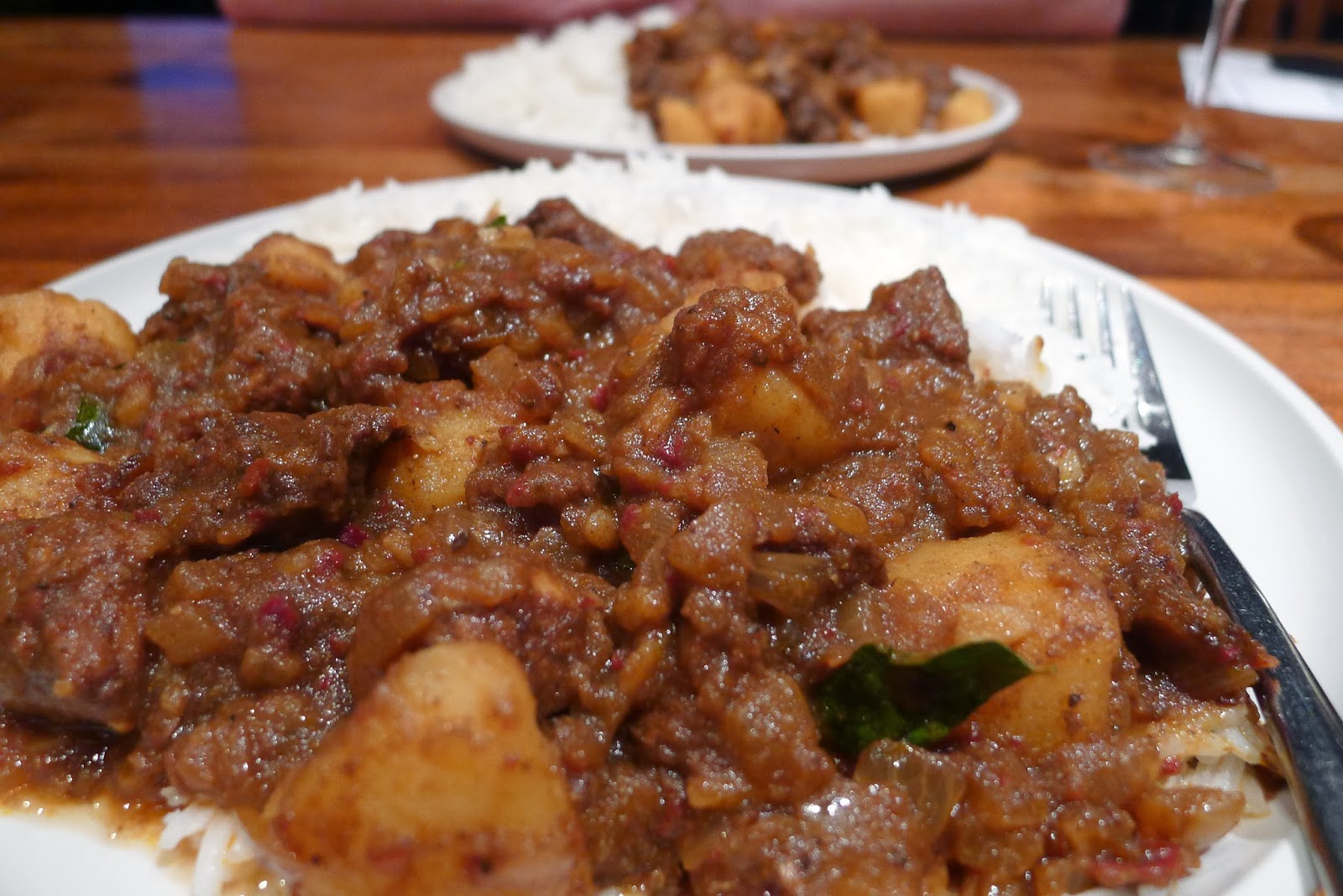This is inspired by a number recipes - one from Das Sreedharan in “Curry”, a Camellia Panjabi recipe from “50 Great Curries of India”, (which oddly is actually a recipe for lamb rather than pork despite the fact that she states herself that Vindaloo is traditionally made with pork) and one online by Anand Solomon, a chef from the state of Karnataka which is next to Goa.
I wasn’t going to include potatoes as I was under the impression they were inauthentic and, much like super-fireyness, invented by UK curry houses. But Solomon includes them and if its good enough for an Indian chef who is renowned for some of his Goan recipes, it is good enough for me.
I’ve used Kashmiri chillies here and deseeded ones at that, and while still quite hot, they’re not blow your brains out hot. You’ll notice that the photo shows only a couple of small onions whereas I state 1 ½ medium ones, but just so you know, there were more propping up the jaggery. Do use pork with a decent amount of fat if you can, such as shoulder.
I have previously briefly discussed Vindaloo’s Portugese origins here but as a reminder “aloo” doesn’t come as is often thought from the Hindi word आलू meaning potato but rather alho which is Portugese for garlic.
I wanted traditional, which despite what the average UK curry house would have you believe, does not mean that your head detaches from your body in some sort of “Scanners” type explosion, and I think this is fairly close to it (despite the inclusion of the potatoes), or as close to traditional as any of my bastardised recipes are. I hope so anyway. Ultimately what you are looking for is spicy, but not excessively hot, and a bit “sweet sour”.
Pork Vindaloo
Serves 2-3
for the spice paste
8-10 dried Kashmiri chillies, soaked in water for 30 mins to soften, then deseeded and chopped
½ tsp cumin seeds
2 cardamom pods, seeds only
3 cloves
1 inch piece of cinnamon stick
¼ star anise
1x⅛ inch piece of ginger, chopped
3 garlic cloves, chopped
1 tsp tamarind concentrate (or 1 ½ tsp tamarind paste)
3 tbsps cider (or white wine) vinegar
For the spice paste firstly grind all the dry ingredients until a fine powder in a spice or coffee grinder, or food processor. Add the “wet” ingredients (including the softened chillis). Then whizz all together until you have a fairly smooth paste.
Heat the oil in a pan and cook the onions over a medium heat for 15 minutes until browned. Add the garlic and cook for 5 minutes more.
Mix in the spice paste & tomato pureé and fry for 5 minutes more, adding a little water as necessary (I reserve the water from soaking the chillies for this purpose).
Tip in the pork and the turmeric and sauté for 10 minutes, stirring occasionally.
Season well with salt & pepper then add the jaggery and 300ml of water.
Bring to the boil then simmer for 20 minutes.
Add the potatoes (and probably a bit more water) and continue to cook for another 20 minutes until the pork is tender and cooked through and the sauce has thickened. Stir occasionally to ensure it doesn’t catch.
Stir in the curry leaves & garam masala, cook for a further 5 minutes and serve with basmati rice.
½ tsp cumin seeds
2 cardamom pods, seeds only
3 cloves
1 inch piece of cinnamon stick
¼ star anise
1x⅛ inch piece of ginger, chopped
3 garlic cloves, chopped
1 tsp tamarind concentrate (or 1 ½ tsp tamarind paste)
3 tbsps cider (or white wine) vinegar
for the curry
2 tbsp rapeseed or groundnut oil
1½ medium onions, finely chopped
2 garlic cloves, finely chopped
2 tsp tomato pureé
½ tsp turmeric powder
400g pork, cubed
sea salt & freshly ground black pepper
¼ tsp jaggery (or palm sugar, or failing that normal sugar)
2 medium potatoes, par boiled and cut into 3cm cubes
8-10 curry leaves
¾ tsp garam masala
1½ medium onions, finely chopped
2 garlic cloves, finely chopped
2 tsp tomato pureé
½ tsp turmeric powder
400g pork, cubed
sea salt & freshly ground black pepper
¼ tsp jaggery (or palm sugar, or failing that normal sugar)
2 medium potatoes, par boiled and cut into 3cm cubes
8-10 curry leaves
¾ tsp garam masala
Mix the cubed pork with a little of the paste in a medium sized bowl - just enough that the cubes of pork are coated - then cover and set aside in a cool place for 30-60 minutes.
Season well with salt & pepper then add the jaggery and 300ml of water.
Add the potatoes (and probably a bit more water) and continue to cook for another 20 minutes until the pork is tender and cooked through and the sauce has thickened. Stir occasionally to ensure it doesn’t catch.






















































